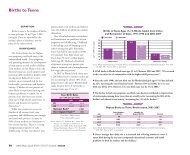2010 Rhode Island Kids Count Factbook
2010 Rhode Island Kids Count Factbook
2010 Rhode Island Kids Count Factbook
Create successful ePaper yourself
Turn your PDF publications into a flip-book with our unique Google optimized e-Paper software.
Permanency for Children in DCYF Care<br />
DEFINITION<br />
Permanency for children in DCYF<br />
Care is the percentage of children in<br />
out-of-home care who transition to a<br />
permanent placement through<br />
reunification, adoption or guardianship.<br />
Data are for all children who were in<br />
out-of-home placement during the<br />
Federal Fiscal Year.<br />
SIGNIFICANCE<br />
The uncertainty of multiple,<br />
prolonged or unstable out-of-home<br />
placements can negatively affect<br />
children’s emotional well-being, identity<br />
formation and sense of belonging,<br />
which have an impact on behavior,<br />
academic achievement, health and longterm<br />
self-sufficiency. 1,2,3 Particular<br />
attention must be paid to populations<br />
of children for whom permanency may<br />
be more difficult to achieve, including<br />
older children, males, children with<br />
disabilities and minority children. 4,5,6<br />
Planning for permanency requires a mix<br />
of family-centered and legal strategies<br />
designed to ensure that children and<br />
youth have safe, stable and lifelong<br />
connections with caring adults. 7,8,9<br />
One of the goals of the federal<br />
Fostering Connections to Success and<br />
Increasing Adoptions Act of 2008 is to<br />
promote permanency through relative<br />
or kinship guardianship and adoption.<br />
The Fostering Connections Act requires<br />
states to notify relatives when a child is<br />
placed in foster care, provides funding<br />
for states offering kinship guardianship<br />
assistance payments, provides incentive<br />
payments for adoptions of older<br />
children and children with special<br />
needs, and requires that states inform<br />
families considering adopting a foster<br />
child about the availability of the<br />
adoption tax credit. 10,11<br />
Youth who age out of foster care<br />
experience high rates of economic<br />
hardship (inability to pay rent, utilities,<br />
etc.), low educational attainment,<br />
hunger, homelessness, unemployment,<br />
and poor physical and mental health.<br />
These youth are more likely to enter the<br />
criminal justice system, become teen<br />
parents and enroll in public assistance<br />
programs. 12<br />
Child welfare agencies can develop<br />
systems that ensure that they are<br />
making progress in achieving youth<br />
outcomes in the areas of employment,<br />
education, housing, life skills,<br />
community connections, personal and<br />
cultural identity, physical and mental<br />
health, and access to legal information<br />
and documents, including medical and<br />
educational histories. 13 The Fostering<br />
Connections Act encourages states to<br />
extend foster care beyond age 18 by<br />
providing federal reimbursement for<br />
foster care, adoption, and guardianship<br />
assistance payments for youth up to the<br />
age of 21. 14,15<br />
Exits from Foster Care*, <strong>Rhode</strong> <strong>Island</strong>, FFY 2009<br />
ALL EXITS WITH DISABILITY OVER AGE 12 AT ENTRY<br />
Adoption 19% 23% 1%<br />
Guardianship 6% 2% 2%<br />
Reunification 60% 50% 70%<br />
Aged Out 10% NA** 16%<br />
Other 5% 24% 12%<br />
Total Number 1,493 470 628<br />
Source: Safety, permanency, and well-being in <strong>Rhode</strong> <strong>Island</strong>: Child welfare outcomes annual report for FY 2009 (Draft).<br />
(2009). New Haven, CT: Prepared by the Consultation Center, Yale University School of Medicine for the Data<br />
Analytic Center of the <strong>Rhode</strong> <strong>Island</strong> Department of Children, Youth & Families. Percentages may not sum to 100%<br />
due to rounding. *Foster Care refers to all out-of-home placements, consistent with language used in federal reports.<br />
**Children with a disability who age out are included in the “other” category.<br />
◆ In Federal Fiscal Year (FFY) 2009, 1,493 children in out-of-home placement in <strong>Rhode</strong><br />
<strong>Island</strong> exited care. Of these, 85% exited to a permanent placement (adoption, guardianship<br />
or reunification). Children with disabilities were somewhat more likely than other children<br />
to exit to adoption and less likely to exit to reunification with their biological family. 16<br />
◆ In FFY 2009, 16% of children in <strong>Rhode</strong> <strong>Island</strong> who entered out-of-home placement reentered<br />
care within 12 months of a prior episode, the same as the rate in FFY 2005. <strong>Rhode</strong><br />
<strong>Island</strong> children re-enter care at almost twice the rate of the national standard (8.6%). 17<br />
Reunification<br />
◆ The percentage of children in the <strong>Rhode</strong> <strong>Island</strong> child welfare system who were reunified<br />
with their family of origin in less than 12 months from the time of removal from the home<br />
decreased from 74% in FFY 2005 to 68% of children in FFY 2009. The national standard<br />
is 76% of reunifications occurring within 12 months of the child’s removal. 18<br />
◆ In FFY 2009, the vast majority (87%) of child maltreatment cases in <strong>Rhode</strong> <strong>Island</strong><br />
involved neglect. 19 The greatest contributors to neglect are poverty, parental substance<br />
abuse and/or mental illness. Achieving timely and successful reunification requires access<br />
to substance abuse and mental health treatment, in-home services, parenting skills<br />
training, assistance in meeting basic needs, child care and specific strategies to decrease<br />
isolation and strengthen community supports. 20<br />
108 <strong>2010</strong> <strong>Rhode</strong> <strong>Island</strong> KIDS COUNT <strong>Factbook</strong> / Safety






